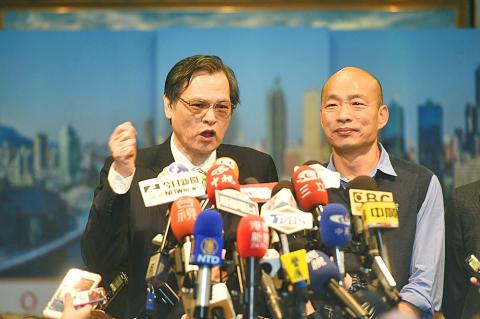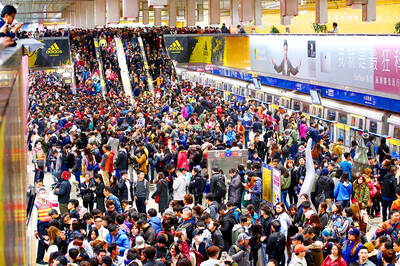Mainland Affairs Council (MAC) Minister Chen Ming-tong (陳明通) yesterday sought the “strategic support” of Kaohsiung Mayor Han Kuo-yu (韓國瑜) in their first public meeting, saying that the distance between Taiwan’s two main political parties should be narrower than that between the Chinese Nationalist Party (KMT) and the Chinese Communist Party (CCP).
The closely watched meeting was held openly in Kaohsiung and lasted about 30 minutes, during which the two officials exchanged their views on cross-strait exchanges.
Chen opened by saying that Beijing’s ultimate goal has always been to annex Taiwan, one of the three “historic missions” for the CCP and its government.

Photo: Chang Chung-i, Taipei Times
“This view is line with one of the two ‘do not doubts’ put forth by Han,” Chen said, referring to Han’s remarks on Jan. 3 that people should not doubt the CCP’s determination to annex Taiwan, nor should they doubt the will of Taiwanese to pursue freedom and democracy.
As Chinese President Xi Jinping (習近平) has laid down plans for unification and put his proposal of adopting a Taiwan version of the “one country, two systems” model on the table, Chen said that he hoped to gain Han’s support and start a strategic dialogue with him.
He produced a copy of Han’s master’s thesis on Beijing’s “united front” tactics that was published in 1988, in an apparent move to remind the mayor that he was once concerned that “the Republic of China [ROC] government has been strenuously fighting for its survival and development under threats of suppression [by the CCP] over the past 40 years.”
“Although Han and I belong to different political camps, we both possess ROC national identification cards. Like I once said, the distance between the pan-blue and pan-green camps, however wide it is, is narrower than that between the pan-blue camp and the ‘red camp’ [CCP],” Chen said.
Han said that as a mayor determined to bring economic prosperity to his city, he would not accept any rigid restrictions Chen might impose on his government, adding that the future Kaohsiung “will only have roads, not walls.”
“What you have in mind are rigid restrictions, while what I have in mind is economic development,” Han said.
“Rest assured, my city will not touch anything related to diplomacy or national defense. Kaohsiung will only be an ‘economic animal,’” he said, urging the council to be a “facilitator” of cross-strait exchanges instead of an “administrator.”
However, Han told Chen that China’s market would not be his sole target, saying that he planned to sign contracts with Malaysia and Singapore after the Lunar New Year holiday to sell Kaohsiung’s agricultural and aquatic products.
Despite brief, heated exchanges, the meeting ended on a conciliatory note after Chen reminded Han to be on the lookout for China’s unification agenda when engaging with it economically, but agreed to help relax restrictions where appropriate.
Throughout the meeting, they did not talk about the so-called “1992 consensus” — a term, former council chairman Su Chi (蘇起) in 2006 admitted making up in 2000, that refers to a tacit understanding between the KMT and the CCP that both sides of the Taiwan Strait acknowledge there is “one China,” with each side having its own interpretation of what “China” means.
Han has said that he would seek closer economic exchanges with Beijing based on the “1992 consensus,” while President Tsai Ing-wen’s (蔡英文) administration has never endorsed it, because it believes the “1992 consensus” means different things for the KMT and the CCP.

READY: The CGA said it closely monitored China’s maritime exercise, deployed vessels to shadow the Chinese ships one-on-one and set up emergency response centers Chinese navy and coast guard ships have returned to China, signaling the end of a massive maritime exercise, authorities said yesterday. The Coast Guard Administration (CGA) released images it said showed Chinese vessels sailing north in rough seas past Taiwan on Thursday, on their way to China. “All the Chinese coast guard went back to China yesterday, so although they have not officially made any announcement, we consider it over,” CGA Deputy Director-General Hsieh Ching-chin (謝慶欽) said. Beijing has not confirmed the drills and the Chinese Ministry of National Defense did not say whether the maneuvers had taken place when asked at a

People can take the Taipei MRT free of charge if they access it at Nanjing Sanmin Station or Taipei Arena Station on the Green Line between 12am and 6am on Jan. 1, the Taipei Department of Transportation said on Friday, outlining its plans to ease crowding during New Year’s events in the capital. More than 200,000 people are expected to attend New Year’s Eve events in Taipei, with singer A-mei (張惠妹) performing at the Taipei Dome and the city government’s New Year’s Eve party at Taipei City Hall Plaza, the department said. As people have tended to use the MRT’s Blue or

PUBLIC TRANSPORT: As some roads would be fully or partially closed, people are advised to take the MRT, with services expanded to accommodate more riders This year’s Taipei Marathon, which has obtained its first gold label certification from World Athletics, is to be held from 5am to 1pm tomorrow and would have 28,000 participants. The race is to start from the Taipei City Plaza and would go through major roads throughout the city, with traffic control implemented from 6am to 2pm, officials said. The Taipei Mass Rapid Transit (MRT) system and New Taipei City MRT Circle line would start operating at 5am on the day of the race, they said. The race would cover Renai Road, Xinyi Road, Hangzhou S Road, Aiguo east and west roads,

Taipei is participating in Osaka’s Festival of Lights this year, with a 3m-tall bubble tea light installation symbolizing Taiwan’s bubble tea culture. The installation is designed as a bubble tea cup and features illustrations of Taipei’s iconic landmarks, such as Taipei 101, the Red House and North Gate, as well as soup dumplings and the matchmaking deity the Old Man Under the Moon (月下老人), affectionately known as Yue Lao (月老). Taipei and Osaka have collaborated closely on tourism and culture since Taipei first participated in the festival in 2018, the Taipei City Department of Information and Tourism said. In February, Osaka represented